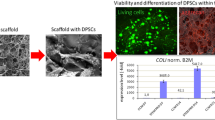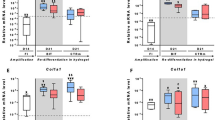Abstract
The field of temporomandibular joint (TMJ) condyle regeneration is hampered by a limited understanding of the phenotype and regeneration potential of cells in mandibular condyle cartilage. It has been shown that chondrocytes derived from hyaline and costal cartilage exhibit a greater chondro-regenerative potential in vitro than those from mandibular condylar cartilage. However, our recent in vivo studies suggest that mandibular condyle cartilage cells do have the potential for cartilage regeneration in osteochondral defects, but that bone regeneration is inadequate. The objective of this study was to determine the regeneration potential of cartilage and bone cells from goat mandibular condyles in two different photocrosslinkable hydrogel systems, PGH and methacrylated gelatin, compared to the well-studied costal chondrocytes. PGH is composed of methacrylated poly(ethylene glycol), gelatin, and heparin. Histology, biochemistry and unconfined compression testing was performed after 4 weeks of culture. For bone derived cells, histology showed that PGH inhibited mineralization, while gelatin supported it. For chondrocytes, costal chondrocytes had robust glycosaminoglycan (GAG) deposition in both PGH and gelatin, and compression properties on par with native condylar cartilage in gelatin. However, they showed signs of hypertrophy in gelatin but not PGH. Conversely, mandibular condyle cartilage chondrocytes only had high GAG deposition in gelatin but not in PGH. These appeared to remain dormant in PGH. These results show that mandibular condyle cartilage cells do have innate regeneration potential but that they are more sensitive to hydrogel material than costal cartilage cells.





Similar content being viewed by others
References
Almarza, A. J., and K. A. Athanasiou. Seeding techniques and scaffolding choice for tissue engineering of the temporomandibular joint disk. Tissue Eng. 10:1787–1795, 2004.
Almarza, A. J., and K. A. Athanasiou. Effects of initial cell seeding density for the tissue engineering of the temporomandibular joint disc. Ann. Biomed. Eng. 33:943–950, 2005.
Almarza, A. J., and K. A. Athanasiou. Effects of hydrostatic pressure on TMJ disc cells. Tissue Eng. 12:1285–1294, 2006.
Almarza, A. J., and K. A. Athanasiou. Evaluation of three growth factors in combinations of two for temporomandibular joint disc tissue engineering. Arch. Oral Biol. 51:215–221, 2006.
Almarza, A. J., A. C. Bean, L. S. Baggett, and K. A. Athanasiou. Biochemical analysis of the porcine temporomandibular joint disc. Br. J. Oral Maxillofac. Surg. 44:124–128, 2006.
Bailey, M. M., L. Wang, C. J. Bode, K. E. Mitchell, and M. S. Detamore. A comparison of human umbilical cord matrix stem cells and temporomandibular joint condylar chondrocytes for tissue engineering temporomandibular joint condylar cartilage. Tissue Eng. 13:2003–2010, 2007.
Bean, A. C., A. J. Almarza, and K. A. Athanasiou. Effects of ascorbic acid concentration on the tissue engineering of the temporomandibular joint disc. Proc. Inst. Mech. Eng. H 220:439–447, 2006.
Brown, B. N., W. L. Chung, A. J. Almarza, M. D. Pavlick, S. N. Reppas, M. W. Ochs, A. J. Russell, and S. F. Badylak. Inductive, scaffold-based, regenerative medicine approach to reconstruction of the temporomandibular joint disk. J. Oral Maxillofac. Surg. 70:2656–2668, 2012.
Chahla, J., K. N. Kunze, T. Tauro, J. Wright-Chisem, B. T. Williams, A. Beletsky, A. B. Yanke, and B. J. Cole. Defining the minimal clinically important difference and patient acceptable symptom state for microfracture of the knee: a psychometric analysis at short-term follow-up. Am. J. Sports Med. 48:876–883, 2020.
Chen, J., A. Chin, A. Almarza, and J. M. Taboas. Hydrogel to guide chondrogenesis versus osteogenesis of mesenchymal stem cells for fabrication of cartilaginous tissues. Biomed. Mater. 2019. https://doi.org/10.1088/1748-605x/ab401f.
Cheng, T., N. C. Maddox, A. W. Wong, R. Rahnama, and A. C. Kuo. Comparison of gene expression patterns in articular cartilage and dedifferentiated articular chondrocytes. J. Orthop. Res. 30:234–245, 2012.
Chin, A., and A. Almarza. Regional dependence in biphasic transversely isotropic parameters in the porcine temporomandibular joint disc and mandibular condylar cartilage. J. Biomech. Eng. 10(1115/1):4046922, 2020.
Chin, A. R., J. Gao, Y. Wang, J. M. Taboas, and A. J. Almarza. Regenerative potential of various soft polymeric scaffolds in the temporomandibular joint condyle. J. Oral Maxillofac. Surg. 76:2019–2026, 2018.
Clancy, R. Nitric oxide alters chondrocyte function by disrupting cytoskeletal signaling complexes. Osteoarthr. Cartil. 7:399–400, 1999.
Cruise, G. M., D. S. Scharp, and J. A. Hubbell. Characterization of permeability and network structure of interfacially photopolymerized poly(ethylene glycol) diacrylate hydrogels. Biomaterials 19:1287–1294, 1998.
Ebert, J. R., G. C. Janes, and D. J. Wood. Post-operative sport participation and satisfaction with return to activity after matrix-induced autologous chondrocyte implantation in the knee. Int. J. Sports Phys. Ther. 15:1–11, 2020.
Francioli, S. E., I. Martin, C. P. Sie, R. Hagg, R. Tommasini, C. Candrian, M. Heberer, and A. Barbero. Growth factors for clinical-scale expansion of human articular chondrocytes: relevance for automated bioreactor systems. Tissue Eng. 13:1227–1234, 2007.
Giannakopoulos H. E., D. P. Sinn, and P. D. Quinn. Biomet Microfixation Temporomandibular Joint Replacement System: a 3-year follow-up study of patients treated during 1995 to 2005. J. Oral Maxillofac. Surg. 70:787–794; discussion 795–786, 2012.
Grayson, W. L., M. Frohlich, K. Yeager, S. Bhumiratana, M. E. Chan, C. Cannizzaro, L. Q. Wan, X. S. Liu, X. E. Guo, and G. Vunjak-Novakovic. Engineering anatomically shaped human bone grafts. Proc. Natl Acad. Sci. USA 107:3299–3304, 2010.
Hagandora, C. K., J. Gao, Y. Wang, and A. J. Almarza. Poly (glycerol sebacate): a novel scaffold material for temporomandibular joint disc engineering. Tissue Eng. A 19:729–737, 2013.
Hagandora, C. K., M. A. Tudares, and A. J. Almarza. The effect of magnesium ion concentration on the fibrocartilage regeneration potential of goat costal chondrocytes. Ann. Biomed. Eng. 40:688–696, 2012.
Hollister, S. J., R. A. Levy, T. M. Chu, J. W. Halloran, and S. E. Feinberg. An image-based approach for designing and manufacturing craniofacial scaffolds. Int. J. Oral Maxillofac. Surg. 29:67–71, 2000.
Hsieh-Bonassera, N. D., I. Wu, J. K. Lin, B. L. Schumacher, A. C. Chen, K. Masuda, W. D. Bugbee, and R. L. Sah. Expansion and redifferentiation of chondrocytes from osteoarthritic cartilage: cells for human cartilage tissue engineering. Tissue Eng. A 15:3513–3523, 2009.
Inderhaug, E., and E. Solheim. Osteochondral autograft transplant (mosaicplasty) for knee articular cartilage defects. JBJS Essent. Surg. Tech. 2019. https://doi.org/10.2106/JBJS.ST.18.00113.
Johns, D. E., and K. A. Athanasiou. Growth factor effects on costal chondrocytes for tissue engineering fibrocartilage. Cell Tissue Res. 333:439–447, 2008.
Kirsch, T., B. Swoboda, and H. Nah. Activation of annexin II and V expression, terminal differentiation, mineralization and apoptosis in human osteoarthritic cartilage. Osteoarthr. Cartil. 8:294–302, 2000.
Leandro, L. F., H. Y. Ono, C. C. Loureiro, K. Marinho, and H. A. Guevara. A ten-year experience and follow-up of three hundred patients fitted with the Biomet/Lorenz Microfixation TMJ replacement system. Int. J. Oral Maxillofac. Surg. 42:1007–1013, 2013.
Li, W., Y. Cheng, L. Wei, B. Li, and H. Zheng. Gender and age differences of temporomandibular joint disc perforation: a cross-sectional study in a population of patients with temporomandibular disorders. J Craniofac. Surg. 30:1497–1498, 2019.
Lin, Y. J., C. N. Yen, Y. C. Hu, Y. C. Wu, C. J. Liao, and I. M. Chu. Chondrocytes culture in three-dimensional porous alginate scaffolds enhanced cell proliferation, matrix synthesis and gene expression. J. Biomed. Mater. Res. A 88:23–33, 2009.
Lin-Gibson, S., S. Bencherif, J. A. Cooper, S. J. Wetzel, J. M. Antonucci, B. M. Vogel, F. Horkay, and N. R. Washburn. Synthesis and characterization of PEG dimethacrylates and their hydrogels. Biomacromolecules 5:1280–1287, 2004.
Lowe, J., R. Bansal, S. Badylak, B. Brown, W. Chung, and A. Almarza. Properties of the temporomandibular joint in growing pigs. J. Biomech. Eng. 2018. https://doi.org/10.1115/1.4039624.
Majima, T., W. Schnabel, and W. Weber. Phenyl-2,4,6-trimethylbenzoylphosphinates as water-soluble photoinitiators—generation and reactivity of O=P(C6H5)(O–) radical-anions. Macromol. Chem. Phys. 192:2307–2315, 1991.
Mansfield, K., R. Rajpurohit, and I. M. Shapiro. Extracellular phosphate ions cause apoptosis of terminally differentiated epiphyseal chondrocytes. J. Cell Physiol. 179:276–286, 1999.
Marie, P. J., A. Lomri, A. Sabbagh, and M. Basle. Culture and behavior of osteoblastic cells isolated from normal trabecular bone surfaces. In Vitro Cell Dev. Biol. 25:373–380, 1989.
Mejersjo, C., and L. Hollender. Radiography of the temporomandibular joint in female patients with TMJ pain or dysfunction. A seven year follow-up. Acta Radiol. Diagn. (Stockh.) 25:169–176, 1984.
Schek, R. M., J. M. Taboas, S. J. Hollister, and P. H. Krebsbach. Tissue engineering osteochondral implants for temporomandibular joint repair. Orthod. Craniofac. Res. 8:313–319, 2005.
Schek, R. M., J. M. Taboas, S. J. Segvich, S. J. Hollister, and P. H. Krebsbach. Engineered osteochondral grafts using biphasic composite solid free-form fabricated scaffolds. Tissue Eng. 10:1376–1385, 2004.
Slynarski, K., W. C. de Jong, M. Snow, J. A. A. Hendriks, C. E. Wilson, and P. Verdonk. Single-stage autologous chondrocyte-based treatment for the repair of knee cartilage lesions: two-year follow-up of a prospective single-arm multicenter study. Am. J. Sports Med. 48:1327–1337, 2020.
Smith, M. H., C. L. Flanagan, J. M. Kemppainen, J. A. Sack, H. Chung, S. Das, S. J. Hollister, and S. E. Feinberg. Computed tomography-based tissue-engineered scaffolds in craniomaxillofacial surgery. Int. J. Med. Robot. 3:207–216, 2007.
Temple, J. P., K. Yeager, S. Bhumiratana, G. Vunjak-Novakovic, and W. L. Grayson. Bioreactor cultivation of anatomically shaped human bone grafts. Methods Mol. Biol. 1202:57–78, 2014.
Tseng, T. H., C. C. Jiang, H. H. Lan, C. N. Chen, and H. Chiang. The five year outcome of a clinical feasibility study using a biphasic construct with minced autologous cartilage to repair osteochondral defects in the knee. Int. Orthop. 2020. https://doi.org/10.1007/s00264-020-04569-y.
Vapniarsky, N., L. W. Huwe, B. Arzi, M. K. Houghton, M. E. Wong, J. W. Wilson, D. C. Hatcher, J. C. Hu, and K. A. Athanasiou. Tissue engineering toward temporomandibular joint disc regeneration. Sci. Transl. Med. 2018. https://doi.org/10.1126/scitranslmed.aaq1802.
Villanueva, I., N. L. Bishop, and S. J. Bryant. Medium osmolarity and pericellular matrix development improves chondrocyte survival when photoencapsulated in poly(ethylene glycol) hydrogels at low densities. Tissue Eng. A 15:3037–3048, 2009.
Wang, L., and M. S. Detamore. Effects of growth factors and glucosamine on porcine mandibular condylar cartilage cells and hyaline cartilage cells for tissue engineering applications. Arch. Oral Biol. 54:1–5, 2009.
Wang, L., M. Lazebnik, and M. S. Detamore. Hyaline cartilage cells outperform mandibular condylar cartilage cells in a TMJ fibrocartilage tissue engineering application. Osteoarthr. Cartil. 17:346–353, 2009.
Williams, J. M., A. Adewunmi, R. M. Schek, C. L. Flanagan, P. H. Krebsbach, S. E. Feinberg, S. J. Hollister, and S. Das. Bone tissue engineering using polycaprolactone scaffolds fabricated via selective laser sintering. Biomaterials 26:4817–4827, 2005.
Zarb, G. A., and G. E. Carlsson. Temporomandibular disorders: osteoarthritis. J. Orofac. Pain 13:295–306, 1999.
Zaucke, F., R. Dinser, P. Maurer, and M. Paulsson. Cartilage oligomeric matrix protein (COMP) and collagen IX are sensitive markers for the differentiation state of articular primary chondrocytes. Biochem. J. 358:17–24, 2001.
Zimmermann, B., H. C. Wachtel, and C. Noppe. Patterns of mineralization in vitro. Cell Tissue Res. 263:483–493, 1991.
Acknowledgments
We would like to acknowledge funding from the School of Dental Medicine at the University of Pittsburgh, as well as from the National Institutes of Health under Grant Numbers T32 EB003392, K01 AR062598, and P30 DE030740.
Author information
Authors and Affiliations
Corresponding author
Additional information
Associate Editor Michael Detamore oversaw the review of this article.
Publisher's Note
Springer Nature remains neutral with regard to jurisdictional claims in published maps and institutional affiliations.
Rights and permissions
About this article
Cite this article
Chin, A.R., Taboas, J.M. & Almarza, A.J. Regenerative Potential of Mandibular Condyle Cartilage and Bone Cells Compared to Costal Cartilage Cells When Seeded in Novel Gelatin Based Hydrogels. Ann Biomed Eng 49, 1353–1363 (2021). https://doi.org/10.1007/s10439-020-02674-y
Received:
Accepted:
Published:
Issue Date:
DOI: https://doi.org/10.1007/s10439-020-02674-y




